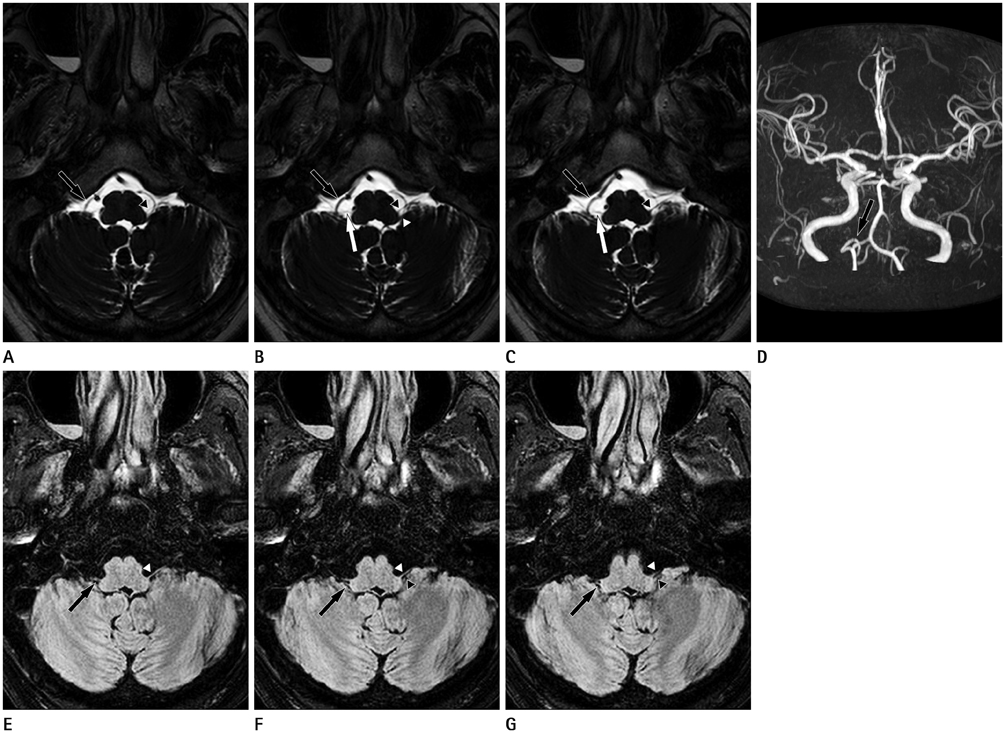J Korean Soc Radiol.
2014 Sep;71(3):107-110. 10.3348/jksr.2014.71.3.107.
Glossopharyngeal Neuralgia with Syncope Caused by Neurovascular Compression and Demonstration by High-Resolution MR Imaging: A Case Report
- Affiliations
-
- 1Department of Radiology, Haeundae Paik Hospital, Inje University College of Medicine, Busan, Korea. sartre81@gmail.com
- KMID: 1736474
- DOI: http://doi.org/10.3348/jksr.2014.71.3.107
Abstract
- Glossopharyngeal neuralgia with syncope is a rare syndrome. It is characterized by paroxysms of neuralgic pain in the throat and pharynx, and is associated with transient loss of consciousness caused by brief periods of cardiac arrhythmia. Glossopharyngeal neuralgia is caused by neoplasm, infection, vascular malformation, or neurovascular compression. Herein, we present a rare case of glossopharyngeal neuralgia with syncope, which was caused by an extrinsic compression of lower cranial nerves in the right cerebellomedullary cistern by the ipsilateral posterior inferior cerebellar artery. In this case, high-resolution MR imaging played a key role in the diagnosis of neurovascular compression induced glossopharyngeal neuralgia.
MeSH Terms
Figure
Reference
-
1. Manzoni GC, Torelli P. Epidemiology of typical and atypical craniofacial neuralgias. Neurol Sci. 2005; 26:Suppl 2. s65–s67.2. Johnston RT, Redding VJ. Glossopharyngeal neuralgia associated with cardiac syncope: long term treatment with permanent pacing and carbamazepine. Br Heart J. 1990; 64:403–405.3. Kanpolat Y, Savas A, Batay F, Sinav A. Computed tomography-guided trigeminal tractotomy-nucleotomy in the management of vagoglossopharyngeal and geniculate neuralgias. Neurosurgery. 1998; 43:484–489. discussion 490.4. Kandan SR, Khan S, Jeyaretna DS, Lhatoo S, Patel NK, Coakham HB. Neuralgia of the glossopharyngeal and vagal nerves: long-term outcome following surgical treatment and literature review. Br J Neurosurg. 2010; 24:441–446.5. Singh PM, Kaur M, Trikha A. An uncommonly common: glossopharyngeal neuralgia. Ann Indian Acad Neurol. 2013; 16:1–8.6. Gaitour E, Nick ST, Roberts C, Gonzalez-Toledo E, Munjampalli S, Minagar A, et al. Glossopharyngeal neuralgia secondary to vascular compression in a patient with multiple sclerosis: a case report. J Med Case Rep. 2012; 6:213.7. Ferrante L, Artico M, Nardacci B, Fraioli B, Cosentino F, Fortuna A. Glossopharyngeal neuralgia with cardiac syncope. Neurosurgery. 1995; 36:58–63. discussion 63.8. Elias J, Kuniyoshi R, Carloni WV, Borges MR, Peixoto CA, Pimentel D. Glossopharyngeal neuralgia associated with cardiac syncope. Arq Bras Cardiol. 2002; 78:510–519.9. Boch AL, Oppenheim C, Biondi A, Marsault C, Philippon J. Glossopharyngeal neuralgia associated with a vascular loop demonstrated by magnetic resonance imaging. Acta Neurochir (Wien). 1998; 140:813–818.10. Hiwatashi A, Matsushima T, Yoshiura T, Tanaka A, Noguchi T, Togao O, et al. MRI of glossopharyngeal neuralgia caused by neurovascular compression. AJR Am J Roentgenol. 2008; 191:578–581.
- Full Text Links
- Actions
-
Cited
- CITED
-
- Close
- Share
- Similar articles
-
- Permanent Pacemaker Implantation in a Patient with Cardiac Syncope Associated with Glossopharyngeal Neuralgia
- Glossopharyngeal Neuralgia Caused by Nerve Compression and Traction by Tortuous Vertebral and Posterior Inferior Cerebellar Arteries
- Syncope Associated With Glossopharyngeal Neuralgia in B-Cell Lymphoma
- Severe Pain Attack Associated with Neurocardiogenic Syncope Induced by Glossopharyngeal Neuralgia: Successful Treatment with Carbamazepine and a Permanent Pacemaker: A Case Report
- A Case of Glossopharyngeal Neuralgia after Tonsillectomy


